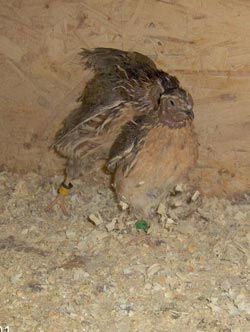Power struggles are best kept out of the public eye: Audiences influence status after quails fights

Although the fights are naturally pretty rough, none of the combatants got seriously injured.<br>Image: Katharina Hirschenhauser<br>
Researchers from the Max Planck Institute for Ornithology in Seewiesen found evidence that both winners and losers exhibit raised testosterone levels after a conflict without an audience. Furthermore, both maintained their social status within their group.
With an audience, on the other hand, this remained true for winners, but not for losers: they had neither raised testosterone levels nor were they able to maintain their dominant status within the group. Thus, informed audiences determine the future social status of a male, while testosterone plays a secondary role.
Battles for territory and mating partners are widespread in the animal world and are usually fought by males. The sex hormone testosterone thereby plays a crucial role. The concentration of this substance often rises dramatically during a fight. However, the social environment in which the rivals fight their battle can change the context and affect the role of testosterone for maintaining dominance. Experience plays a role, for instance, how often the opponents got involved in a conflict and whether they have met before. Of crucial importance can also be whether the fight is watched by spectators. Audiences can have a decisive effect on the outcome of a contest between humans, too.
With support of the Alexander-von-Humboldt Society, scientists working with Katharina Hirschenhauser from the Max Planck Institute for Ornithology in Seewiesen have been studying the influence of mixed-sex audiences on future social status after a fight. They kept quails in social groups each consisting of two males (one dominant and one subordinate) and three females. The scientists observed fights between two dominant male quails in a central arena. The members of the respective social group either were allowed to watch the fight or not. During the fighting phase, which lasted an average of seven minutes, the eventual winners attacked their rivals 29 times on average. Although the fights are naturally pretty rough, none of the combatants got seriously injured.
The winners, without exception, retained their dominant status (“the winner effect”). The losers, on the other hand, were often “beaten up” by the previously subordinate male after returning to their social group and on a long-term lost their dominant status (“the loser effect”). Where there was no audience present, however, even the losers were able to maintain their dominant status.
As expected, testosterone levels were raised after the fight when there was no audience. This happened regardless of whether the quails had won or lost. After a fight in front of an audience, though, the losers had lower testosterone levels. The winners, on the other hand, showed a similar increase to quails that had fought without an audience. In order to determine whether a change in status after losing a fight in front of an audience could be physiologically prevented, the scientists treated the losers immediately after the fight with a testosterone cream on the skin. This treatment seriously influenced the birds' aggressive behaviour: the losers were chasing the subordinate male in the group to a greater extent, which enabled them to remain dominant. This seems to indicate that testosterone is a mediator of the “winner effect” – or at the loser’s side, its lack has an influence on future success.
However, the scientists went a step further: They injected the winners with a testosterone blocker directly after the fight and observed their behaviour in the social group. Although, through the blocker, the testosterone had no effect on these birds temporarily, the winners were still able to maintain their social status. “Apparently, the information about a fight essentially determines the loser’s future status in its group. The “winner effect”, in contrast, is independent of testosterone and audiences,” says Katharina Hirschenhauser, lead author of the study. Next, the scientists would like to test the direction of information use, in other words how the combatants behave if they do not see the audiences, but the observers are fully informed about the fight's outcome. (SL)
Contact:
PD Dr. Wolfgang Goymann
Department of Behavioural Neurobiology
Max Planck Institute for Ornithology
82319 Seewiesen
Tel.: 08157 932-301
E-mail: goymann@orn.mpg.de
Dr. Katharina Hirschenhauser
E-mail: khirschenhauser@orn.mpg.de
Original publication:
Katharina Hirschenhauser, Manfred Gahr, Wolfgang Goymann
Winning and losing in public: Audiences direct future success in Japanese quail
Hormones and Behavior, in press
Media Contact
More Information:
http://www.orn.mpg.deAll latest news from the category: Life Sciences and Chemistry
Articles and reports from the Life Sciences and chemistry area deal with applied and basic research into modern biology, chemistry and human medicine.
Valuable information can be found on a range of life sciences fields including bacteriology, biochemistry, bionics, bioinformatics, biophysics, biotechnology, genetics, geobotany, human biology, marine biology, microbiology, molecular biology, cellular biology, zoology, bioinorganic chemistry, microchemistry and environmental chemistry.
Newest articles

Properties of new materials for microchips
… can now be measured well. Reseachers of Delft University of Technology demonstrated measuring performance properties of ultrathin silicon membranes. Making ever smaller and more powerful chips requires new ultrathin…

Floating solar’s potential
… to support sustainable development by addressing climate, water, and energy goals holistically. A new study published this week in Nature Energy raises the potential for floating solar photovoltaics (FPV)…

Skyrmions move at record speeds
… a step towards the computing of the future. An international research team led by scientists from the CNRS1 has discovered that the magnetic nanobubbles2 known as skyrmions can be…





















